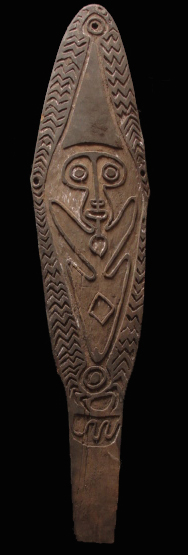
A gope board (or kwoi) is a wooden ritual object made in the Papuan Gulf of New Guinea. Each board represents the spirit of an ancestral hero that can protect clans from evil spirits and death.

A gope board (or kwoi) is a wooden ritual object made in the Papuan Gulf of New Guinea. Each board represents the spirit of an ancestral hero that can protect clans from evil spirits and death.
Gope is a term for a spiritually charged carved board made to represent an ancestral hero in the Papuan Gulf of Papua New Guinea. [1] Papuan Gulf people of Kikori, Baimaru, Uruma, Hohao, and Orokolo [2] refer to these sculptured boards as Kwoi.
The sculptures are often made from the sides of an old canoe. [3]
Gope sculptures are believed to protect the island clansmen from evil spirits and death [4] A full size board is made and named by the uncle of a boy for his initiation (into adulthood) ceremony. Also, warriors are awarded gope boards for each act of bravery they perform in battle—these boards are often made from the remains of an enemy's canoe. Gope boards have a consistent elliptical shape and can vary in size up to eight feet long. They are carved in relief and then painted with lime (to whiten), red ochre, and other native paints. Gope boards have a similar style and may depict the face of an ancestral spirit. Small unnamed gope boards are sometimes given to uninitiated boys.[ citation needed ]
Gope boards are also used in raids on other clans and headhunting missions. They are consulted as to which enemy to attack, and the spirits contained in the boards are thought to go in advance of the warriors to sap the enemies of their strength. Agiba (or "skull racks") are similar to Gope boards and are used to display any skulls won in battle. [5]

The Gulf of Papua is located in the southern coast region of New Guinea. It has a total surface area of 70,400 km2 (27,200 sq mi).
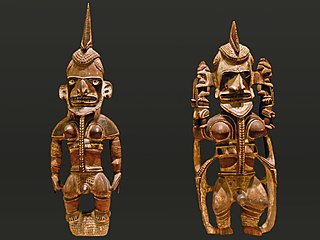
Uli figures are wooden statues from New Ireland in Papua New Guinea. Like their neighbors to the north and south, the artistic traditions of the peoples of central New Ireland formerly focused largely around mortuary rites. In contrast to the intricate malagan carvings of the north, artists in central New Ireland produced less ornate but more permanent figures known as uli, which were kept and reused many times. No longer made today, uli were displayed as part of lengthy fertility rites involving the exhumation and reburial of human skulls, which accompanied the planting of sacred plants.
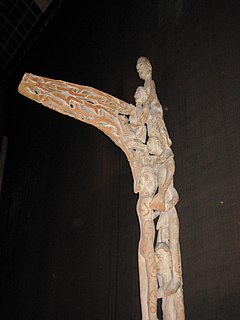
A Bisj or Bis pole is a ritual artifact created and used by the Asmat people of south-western New Guinea, Indonesia. Bisj poles can be erected as an act of revenge, to pay homage to the ancestors, to calm the spirits of the deceased and to bring harmony and spiritual strength to the community.

The culture of Papua New Guinea is many-sided and complex. It is estimated that more than 7000 different cultural groups exist in Papua New Guinea, and most groups have their own language. Because of this diversity, in which they take pride, many different styles of cultural expression have emerged; each group has created its own expressive forms in art, dance, weaponry, costumes, singing, music, architecture and much more. To unify the nation, the language Tok Pisin, once called Neo-Melanesian has evolved as the lingua franca — the medium through which diverse language groups are able to communicate with one another in Parliament, in the news media, and elsewhere. People typically live in villages or dispersed hamlets which rely on the subsistence farming of yams and taro. The principal livestock in traditional Papua New Guinea is the oceanic pig.
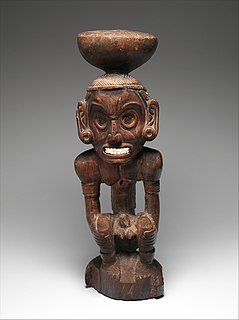
A zemi or cemi was a deity or ancestral spirit, and a sculptural object housing the spirit, among the Taíno people of the Caribbean. They were also created by indigenous South Americans.

Papua New Guinean art has a long rich diverse tradition. In particular, it is world-famous for carved wooden sculpture: masks, canoes and story-boards. Papua New Guinea also has a wide variety of clay, stone, bone, animal and natural die art. Many of the best collections of these are held in overseas museums.
The Papuans are one of four major cultural groups of Papua New Guinea. The majority of the population lives in rural areas. In isolated areas there remains a handful of the giant communal structures that previously housed the whole male population, with a circling cluster of huts for the women. The Papuan people are Melanesian people composed of at least 240 different peoples, each with its own language and culture. Sago is the staple food of the Papuan supplemented with hunting, fishing and small gardens.

Hiri is the name for the traditional trade voyages that formed an important part of the culture of the Motu people of Papua New Guinea.

The Marind or Marind-Anim are an ethnic group of New Guinea, residing in the province of South Papua, Indonesia.
The Songye people, sometimes written Songe, are a Bantu ethnic group from the central Democratic Republic of the Congo. They inhabit a vast territory between the Sankuru and Lubilash rivers in the west and the Lualaba River in the east. Many Songye villages can be found in present-day East Kasai province, parts of Katanga and Kivu Province. The people of Songye are divided into thirty-four conglomerate societies; each society is led by a single chief with a Judiciary Council of elders and nobles (bilolo). Smaller kingdoms east of the Lomami River refer to themselves as Songye, other kingdoms in the west, refer to themselves as Kalebwe, Eki, Ilande, Bala, Chofwe, Sanga and Tempa. As a society, the people of Songye are mainly known as a farming community; they do, however, take part in hunting and trading with other neighboring communities.

In 1994, Jim Mason, a graduate student in the Department of Anthropology at Stanford University, arranged for two groups of men from the Sepik River region of Papua New Guinea to carve the New Guinea Sculpture Garden at Stanford University. The men were from several communities or villages of the Iatmul people and the Kwoma people.

Ikegobo, the Edo term for "altars to the Hand," are a type of cylindrical sculpture from the Benin Empire. Used as a cultural marker of an individual's accomplishments, Ikegobo are dedicated to the hand, from which the people of Benin considered the will for wealth and success to originate. These commemorative objects are made of wood or brass with figures carved in relief around their sides.
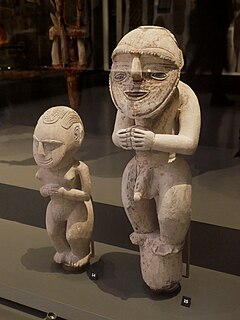
Kulap figurines of limestone or chalk were made in Melanesia. The small funerary sculptures from New Ireland were associated with death rituals. They are typical in the hilly Punam region of the New Ireland province in Papua New Guinea of the Bismarck Archipelago. They were believed to contain the soul of the deceased person whom they were meant to represent, and would be ritually smashed once their usefulness or the period of mourning was over. In more recent years, some have been sold in their intact forms to Westerners, particularly to German administrators.

The Iatmul are a large ethnic group of about 10,000 people inhabiting some two-dozen politically autonomous villages along the middle Sepik River in Papua New Guinea. The communities are roughly grouped according to dialect of the Iatmül language as well as sociocultural affinities. The Iatmul are best known for their art, men's houses, male initiation, elaborate totemic systems, and a famous ritual called naven, first studied by Gregory Bateson in the 1930s. More recently, Iatmul are known as a location for tourists and adventure travellers, and a prominent role in the 1988 documentary film Cannibal Tours.

Kundu is a pidgin name in Papua New Guinea for an hourglass shaped drum used to accompany formal occasions, religious ceremonies and for celebrations. This drum is emblematic of Papua New Guinea and it appears on the country's coat of arms.
Mua people (Mualgal) alternatively the Moa, are an indigenous Australian Torres Strait Island people based on Moa. According to Alfred Cort Haddon their lifestyle, culture, myths and kinship networks overlapped closely with those of the Kaurareg on neighbouring Muralag, while also forming an integral part, linguistically and culturally, with all Western and Central Island peoples of Torres Strait.

The Papua New Guinea National Museum and Art Gallery (NMAG) is a museum and art gallery in Waigani, Port Moresby, Papua New Guinea. It is the national museum of Papua New Guinea.
Owen Yalandja is Aboriginal Australian carver, painter and singer of the Kuninjku people from western Arnhem Land, Australia. A senior member of the Dangkorlo clan, who are the Indigenous custodians of an important site related to female water spirits known as yawkyawk, Yalandja has become internationally renowned for his painted carvings of these spirits, as well as his paintings on eucalyptus bark.
Crusoe Kuningbal or Guningbal (1922–1984) was an Aboriginal Australian artist from Maningrida in the Northern Territory, known for a pointillist technique and tall, slim sculptures of mimih spirits. In addition to his art, Kuningbal was a prominent cultural figure in his region, as he sang and performed in important ceremonies, most notably that of the Mamurrng.
Crusoe Kurddal was an Aboriginal Australian artist known for his Mimih and Yawkyawk sculptures, and acting roles.